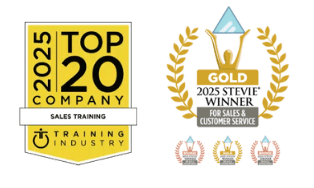It’s an age-old saying that people buy from people.
More people buy from people they trust – but most importantly, they buy from people they trust and whom they like.
One statistic remains true after conducting many win/loss reviews with our clients. Where we are successful and where we win, we have identified and built strong working relationships with key client decision-makers for that specific sales opportunity. This is a relationship with someone who has the political authority, personal self-interest, and determination to help us succeed.
Conversely, it is also true that where we fail to win, we’ve yet to secure such relationships.
This article aims to help you, as a Sales Professional, identify, gain access to, and build trust-based working relationships with these key decision-makers.
Step 1 – Mapping Decision-Makers
With any new opportunity, we first recommend mapping the individual contacts that will play a role in the client decision-making process.
For each contact, we discuss their political power and the strength of our current relationship, rating them from detractor through neutral to supporter. Use whatever mapping tool you have at your disposal (Our clients use the Revenue Storm Relationship Barometer™ App).
During the early stages of a sales pursuit, the picture can, on first viewing, appear a little depressing as our relationships often need to be stronger and more cohesive with those further up the organization with the most political power and authority. Therefore, we frequently face a challenge: “How do we access more senior executives and move them towards becoming our supporters?”
As with most aspects of selling, success depends on doing our homework and putting effort into our preparations.
Step 2 – Business Agendas
Having mapped the “key players” that we believe will have a role in the decision-making process, we can then start planning our executive engagement strategy.
Typically, senior executives are focused on a small handful of critical business objectives for any given financial period. These will be aligned to the strategic direction of their company and/or their division within it. As such, this is where they are prepared to invest their time – in their “business agenda” – both challenges and opportunities.
Our job is to uncover details of these business agendas for each of our target executives.
We can do this in many ways – through annual reports, social media, and client speaking engagements, or through other contacts we may have elsewhere within the client organization that may be willing to help us by providing relevant information.
Step 3 – Gaining Access – Triggering Interest
Whether made directly or via a recommendation from another client contact, it is critical when making our meeting request, we trigger the interest of our target client executive by ensuring that our business value messaging, i.e., the reason we are seeking a meeting, is aligned with at least one of their strategic priorities – giving them a reason to say yes to a meeting.
The good news is that no matter what level of seniority we reach in our organizations, achieving our business goals is increasingly tough. Even the most senior executives can be open to help.
Be respectful of our target client’s time. Once we are confident that we have a compelling “triggering message” and are ready to make our approach, it is important to know how much time to request for our initial meeting.
Rule-of-thumb – we suggest asking for a maximum of 15/20 minutes for an initial meeting. Requesting longer meetings with a senior executive that we have never met is unlikely to succeed; even if we do have a compelling proposition, we are likely, at best, to be referred further down the organization, below those with the authority to make the real decisions.
Step 4 – Encounter Planning
Success!!! Our approach has worked, our reason for requesting a brief meeting has succeeded, and we have a meeting scheduled.
We now need to turn our focus to “execution.”
Our primary objective for our all-important initial meeting must be to connect with our client’s business agenda in a way that will secure a follow-up meeting either with them or a personal referral to another key decision-maker to advance our proposals.
By planning what outcomes we want to achieve, we can then focus on our messaging once in the meeting. Which emotions do we want to trigger? What’s our point of view that’s going to stimulate conversation – executives thrive on debating and exchanging points of view. Do we want to excite our client about a potential opportunity, disturb their thinking around a risk facing their business, or assure them that we can help them? Perhaps a mix of all three?
By carefully planning, we can focus on our meeting from every angle. Once we have crafted our story, it’s a matter of rehearse, rehearse, rehearse… until we are ready to execute a clear, concise, and compelling meeting execution plan.
Note: Encounter planning, or preparing for a client meeting, is covered at length in, “Encounter Planning for the Win,” a previous Coaching Moment Article.
Step 5 – First Impressions Count
Another truism is that we only get one chance to make a first impression.
Experience would suggest that success or failure in these critical initial meetings will be determined by what comes out of our mouths within the first few minutes of entering the meeting.
After polite introductions, quickly get to the point and reaffirm why we requested the meeting.
As we speak, imagine that our clients will ask themselves three questions.
First, “What does this person know about my world, business challenges, and opportunities?”
Give to get – having done our homework, we should open with our intelligent, thoughtful “point of view,” testing our understanding of a specific business challenge or opportunity that we have come to discuss – an engaging response will confirm we have done our research well.
Second, our client may wonder, “Why should I trust this person to help me?”
As the conversation progresses, we share our views on the possibilities we see and how we believe our firm can play a role in helping our client to succeed. Recounting success stories of other clients facing similar challenges/opportunities adds credibility to our claims.
Hopefully, by now, we have answered the first two “silent questions,” the third (hopefully) being “What can this person do to help me and my business?”
Our opportunity to ask for what we are there for… to achieve the outcome we planned and rehearsed. Be specific and be confident. Executives are in their roles to make decisions and things happen – so ask.
Again, be respectful and stick to the time allocated.
Hopefully, by now, we will have done enough to create a good first impression and persuade our client that spending further time with us could be valuable and help them succeed with their business agenda – the beginnings of a promising relationship.
Step 6 – Active Executive Support – Our Ultimate Goal
As suggested, our ultimate goal is to secure a powerful client contact as an “active supporter” – someone with the political power, personal self-interest, and determination to help us succeed.
Initially we focus on uncovering our client’s business agenda and aim to resonate our value proposition in support of enabling it.
To develop our relationship with “active supporters,” we also need to understand our client’s personal agenda, i.e., their business goals and aspirations.
This step takes time and usually more than a single meeting. To obtain this insight we have to earn our client’s trust. If we can demonstrate that by working with us our client can not only advance their business agenda but also their personal agenda, they will then have the motivation to align their support to our success and where necessary take political risk on our behalf – in other words become an “active supporter”.
We started by reminding ourselves that “people buy from people.” It’s true; our research shows that 70% plus of opportunities are won by understanding and maneuvering client politics and developing the right relationships.
We often hear, “But our competitors have better relationships” – however, it is worth remembering that if they do appear to have stronger client relationships, it is only because they have worked overtime to build them. No one is born “loving company XYZ.” Our success is determined by how much effort we are prepared to put in.
Following the six steps above will significantly improve our ability to build rewarding, trust-based relationships. Then, our success rates are bound to follow
Personal Challenge: Select an upcoming sales opportunity and focus early on identifying the key decision makers, qualifying our current relationships with them, and putting an executive engagement plan together in line with the steps suggested above.




